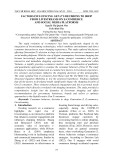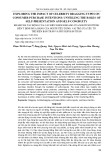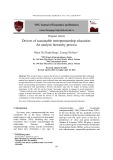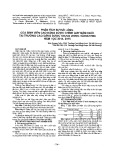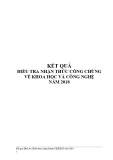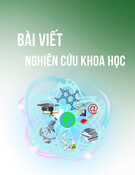
VNU Journal of Economics and Business, Vol. 4, No. 2 (2024) 103-112
103
Original Article
The relationship between work environment and employees’
innovative work behaviours: A proposed model
Tran Thi Thu Hai1,*, Mai Thanh Lan2, Luu Thi Minh Ngoc3
1VNU University of Economics and Business
No. 144 Xuan Thuy Road, Cau Giay District, Hanoi, Vietnam
2Thuong Mai University
No. 79 Ho Tung Mau Road, Cau Giay District, Hanoi, Vietnam
3VNU International School
No. 144 Xuan Thuy Road, Cau Giay District, Hanoi, Vietnam
Received: March 6, 2024
Revised: April 23, 2024; Accepted: April 25, 2024
Abstract: Employees’ innovative work behaviours (IWB) emphasize the multifaceted nature of
employee contributions to organizational innovation, encompassing both the ideation stage and the
necessary implementation behaviours that translate innovative ideas into tangible performance
improvements. Fostering a work environment that encourages and celebrates IWB becomes crucial
for organizations seeking to maximize their innovation potential. This study delves into the intricate
relationship between work environment, encompassing both its social and physical facets, and IWB.
Building upon theoretical foundations in innovation, innovative behaviour, and work environment
research, the article presents an analytical framework to unravel the influence of these factors. The
proposed framework leverages an integrated approach by combining insights from Affective Events
Theory (AET) and Expanded Person-Environment Fit (PEF) theory. This integrated lens posits that
IWB are shaped by both the social and physical environment, mediated by innovation trust, with
personal innovativeness acting as a moderator. This framework paves the way for further research
in the fields of innovation management.
Keywords: Innovation, work environment, IWB, AET, PEF.
1. Introduction *
Innovation is not a new concept, but it is
multifaceted and remains the key to creating
competitive advantages for businesses (Zhang &
Bartol, 2010; Phung & Le, 2013; Pham, 2014;
________
* Corresponding author
E-mail address: haitrantt@vnu.edu.vn
https://doi.org/10.57110/vnujeb.v2i6.268
Copyright © 2024 The author(s)
Licensing: This article is published under a CC BY-NC
4.0 license.
Nham et al., 2021; Abioye et al., 2021).
Organizations face differing innovation
challenges; some seek to capitalize on new
opportunities, while others aim to overcome
critical issues impacting their survival.
VNU Journal of Economics and Business
Journal homepage: https://jeb.ueb.edu.vn

T.T.T. Hai et al. / VNU Journal of Economics and Business, Vol. 4, No. 2 (2024) 103-112
104
Furthermore, researchers acknowledge that
common indicators for measuring innovation,
such as R&D spending, R&D employee
numbers, and patents, are not suitable measures
for every specific context (Afsar, 2016). This
highlights the need for a deeper understanding of
what innovation is, how it occurs, and the impact
of specific work environment characteristics on
employees' innovative work behaviours (IWB).
A multitude of factors, encompassing
individual characteristics and contextual
elements, have been identified as influencing
innovation (Afsar, 2016; Emiralioglu & Sonmez,
2021). One critical link lies in the reciprocal
relationship between individual behaviour and
the work environment. As Afsar (2016) posits,
individuals' interactions with their work
environment shape their behaviour, including
propensity for innovation. Consequently,
fostering a work environment that encourages
and celebrates IWB becomes crucial for
organizations seeking to maximize their
innovation potential.
Employees play a pivotal role in this process,
serving as the engines of idea generation,
adaptation, and implementation - actions
collectively termed “innovative behaviour”
(Lee, 2008). However, engaging in such
behaviour can be perceived as venturing outside
established norms and potentially risky for
individual employees (Lee, 2008). Therefore,
nurturing and managing an internal context that
actively supports and incentivizes IWB becomes
imperative for organizational success (Alpkan et
al., 2010). This paper will develop a theoretically
grounded framework for the work environment-
innovative behaviour relationship through
comprehensive research synthesis.
2. Literature review
2.1. Innovation and Innovative work behaviour
The concept of innovation has been
interpreted and defined in various ways.
Accrording to Baregheh et al.
(2009): ”Innovation is the multi-stage process
whereby organizations transform ideas into
new/improved products, service or processes, in
order to advance, compete and differentiate
themselves successfully”. Pham (2014) defines
innovation as the utilization of new ideas,
initiatives, or knowledge, transforming them into
commercially viable products or services. Nham
et al. (2021) emphasize the transformative nature
of innovation, viewing it as the introduction of
radically new or substantially improved products
(or services) alongside novel production
processes, marketing approaches, and
organizational structures. This fact leads to
enhanced organizational value creation or
widespread societal adoption. Nguyen et al.
(2023) focus on the processual dimension of
innovation, defining it as a value-creation
process involving the construction,
development, and realization of ideas, new
technologies, products, and services. This study,
acknowledging the merits of each perspective,
conceptualizes innovation as the application of
an enterprise's available knowledge, skills, and
resources to undertake technical or non-technical
innovation activities.
Amidst intensifying global competition, the
role of innovation in enhancing organizational
productivity and efficiency has become
demonstrably paramount (Crespi & Zuniga,
2011). While competitive advantages may stem
from diverse sources, successful organizations in
today's landscape are often those adept at
mobilizing knowledge and technology, wielding
them to pioneer novelties in their product
offerings, service portfolios, and even market
penetration strategies (Strobl et al., 2018). In
fact, innovations that cater to user needs and
amplify operational efficiency are the very
lifeblood of business survival, growth, and
sustained competitive edge (Rozman & Kovac,
2015; Nham et al., 2021).
Innovative work behaviours are a
multifaceted concept encompassing a variety of
employee actions and dispositions that
contribute to the development, introduction, and
implementation of new ideas for products,
processes, or working methods within an
organization (Scott & Bruce, 1994; Bilal et al.,
2020; Grošelj et al., 2021). IWB encompass
diverse activities within an organization. They
transcend the singular act of identifying
problems and generating solutions. As de Jong
and Hartog (2010) outlined, IWB include
mobilizing resources, both tangible and
intangible, to operationalize and nurture nascent

T.T.T. Hai et al. / VNU Journal of Economics and Business, Vol. 4, No. 2 (2024) 103-112
105
ideas. Strobl et al. (2018) further elaborated on
this point, highlighting that IWB extend beyond
conceptualizing novel products, services, or
processes. They encompasses the refinement of
existing work practices, and the inventive
reconfiguration and combination of readily
available resources to address perceived
challenges. Hence, IWB emerge not solely from
designated innovation sessions. They can occur
at any time and in any context within an
organization.
2.2. Work environment
2.2.1. Social environment
Social environment refers to the dynamic
interplay of people’s interactions, activities, and
capabilities (Dul & Ceylan, 2014). This is where
ideas are created and developed, shaped by the
perceptions and knowledge shared within an
organization. Building on this concept, West and
Anderson (1998) proposed a model of an
organizational environment supportive of
innovation, highlighting four key elements:
vision, safety for members, mission orientation,
and organizational support. Furthermore,
corporate culture, as defined by Tomi et al.
(2014), also constitutes a crucial aspect of the
social environment. The influence of corporate
culture on facilitating innovation has been well-
documented, with several key characteristics
emerging from empirical research. These
include: supportive and secure environment,
constructive conflict management, high value
placed on creativity and diversity, long-term vision
and risk tolerance, leadership commitment to
innovation, open communication culture.
The organizational social environment
plays a decisive role in shaping the behaviours
and outcomes of business members. Notably,
Amabile et al. (1996) developed the KEYS
model, a widely used instrument for assessing
the creative climate within organizations
(Almelegy et al., 2016). This model posits that
the creative work environment emerges from the
dynamic interplay of individual personalities,
leadership styles, organizational policies, and
interpersonal interactions across all levels, from
upper management to frontline employees
(Amabile et al., 2013).
2.2.2. Physical environment
The physical environment of a business,
encompassing aspects like layout, atmosphere,
design, lighting, and aesthetics, has emerged as
a key differentiator impacting business success
(Elsback & Stigliani, 2018). Organizations are
increasingly leveraging strategic design
interventions to craft unique spatial experiences
for stakeholders, including partners, customers,
and employees, setting themselves apart from
competitors.
Within a business setting, physical
environment encompasses the tangible elements
and prevailing conditions that shape its space.
This includes both natural aspects, such as air
quality and lighting, and human-made
components, encompassing layout, design,
furnishings, and equipment (Oksanen & Stahle,
2013; Blomberg & Kallio, 2022). Notably,
humans actively define this environment through
the design and construction of buildings, the
implementation of floor plans, and the selection
of surrounding objects. Furthermore, the
physical environment exerts a reciprocal
influence on its inhabitants, impacting the
individuals who work within it.
The physical environment acts as a critical
moderator of organizational activities,
simultaneously enabling and restricting them
(Kamarulzaman et al., 2011; Elsback &
Stigliani, 2018; Peng & Jia, 2023). From
production processes to research endeavors and
new product development, every organizational
endeavor is demonstrably influenced by the
design and configuration of machinery,
workspaces, environmental controls, and
equipment. Moreover, the relative permanence
of physical environments necessitates
meticulous consideration during design
decisions. A thorough understanding of the
impact on both the organization and its members
is crucial in shaping these spaces (Oksanen &
Stahle, 2013).
2.3. The relationship between work environment
and employees’ innovative work behaviours
2.3.1. The relationship between social
environment and employees’ innovative work
behaviours
Extant research has established a robust
relationship between social environment and

T.T.T. Hai et al. / VNU Journal of Economics and Business, Vol. 4, No. 2 (2024) 103-112
106
IWB. This stems from the understanding that
creativity acts as the seedbed for innovation, as
aptly put, “all innovation begins with creative
ideas” (Amabile et al., 2013). Notably, IWB
manifest within the organizational context
through intricate interactions between members,
thus highlighting the undeniable influence of
social environment on fostering or hindering
such behaviours.
Assessments of work environments
conducive to innovation primarily focus on
factors pertaining to the social dimension. For
instance, the Creative Climate Questionnaire
(CCQ) by Ekvall (1996) measures elements like
challenge, freedom, support for idea
development, trust, dynamism, humor, debate,
conflict, risk-taking, and time for idea
development. Similarly, the KEYS scale by
Amabile et al. (1996) assesses factors such as
organizational and supervisory encouragement,
workgroup support, resource availability,
challenges, autonomy, obstacles, pressure,
creativity, and productivity. Further examples
include the Siegel Scale of Support for
Innovation (SSSI) by Siegel and Kaemmerer
(1978), which examines leadership, ownership,
norms of diversity, continuous development, and
consistency. Additionally, the Team Climate
Inventory (TCI) by Anderson and West (1998)
emphasizes factors like vision, safety, task
orientation, and support for innovation.
Previous researches support the notion that
employees across all hierarchical levels possess
the potential to contribute directly or indirectly
to organizational innovation (Lizarelli et al.,
2023). This is particularly true in less
hierarchical organizational structures, where
opportunities for all employees to engage in
IWB are more readily available (Hull et al.,
2020). Studies have further demonstrated a
positive association between innovation-
supportive social environments and increased
employee engagement in IWB. Employees
within such environments are not only more
likely to generate innovative ideas themselves,
but they also exhibit greater openness to novel
concepts and a higher propensity for risk-taking.
2.3.2. The relationship between physical
environment and employees’ innovative work
behaviours
Physical environment, an artifact of human
design and utilization, acts as a physical
manifestation of an organization's desires and
strategies, including its innovation endeavors
(O’Toole, 2001; Cheah & Ho, 2019; Peng & Jia,
2023). By serving as a tangible representation of
organizational values and objectives, physical
environment facilitates employee understanding
and alignment with desired behaviours and
goals, including those pertaining to innovation.
This intricate relationship forms the basis of
Moultrie et al.'s (2007) theoretical framework for
innovation, which highlights the physical
environment's role in shaping and reflecting
innovation strategies.
For decades, environmental psychologists
have explored the intricate relationship between
physical surroundings and human behaviour.
The Stimuli-Organism-Response model,
pioneered by Mehrabian and Russell, serves as a
robust cognitive framework for analyzing this
dynamic (Horng et al., 2013). This model posits
three independent emotional dimensions -
pleasure, arousal, and dominance - that
collectively define a person's state. Notably, it
allows us to understand employees' emotions
and subsequent behavioural responses within the
context of their work environment.
Specifically, sensory inputs such as
brightness, ambient noise levels, color schemes,
materials, and even atmospheric factors like
temperature and humidity all contribute to
shaping specific behavioural reactions in
employees. By understanding these intricate
connections, we can design workspaces that
optimize emotional well-being and potentially
enhance IWB.
2.4. Work environment assessment tools
2.4.1. Creative Climate Questionnaire- CCQ
The Creative Climate Questionnaire (CCQ),
developed by Ekvall (1996), serves as an
instrument for assessing organizational factors
that either stimulate or impede innovation. This
tool delves into the concept of organizational
climate, defined as the collective “attitudes,
emotions, and behaviours that characterize life in
an organization” (Ekvall, 1996). The work
environment itself operates as an intermediary
variable, influencing critical organizational
processes like problem-solving, communication,
and creativity. Research suggests that this work
environment significantly impacts various

T.T.T. Hai et al. / VNU Journal of Economics and Business, Vol. 4, No. 2 (2024) 103-112
107
outcomes, including quality, productivity,
innovation, employee satisfaction, and overall
organizational profitability (Ekvall, 1996).
Furthermore, a reciprocal relationship exists
between the work environment and
organizational resources, such as personnel,
infrastructure, and financial capital. These
resources shape the work environment, while the
environment itself influences how effectively
these resources are utilized. Notably, Ekvall
(1996) emphasizes the CCQ's ability to measure
conditions that foster creativity among
organizational members, ultimately promoting
innovation within the organization.
The development of the Creative Climate
Questionnaire (CCQ) was informed by a
comprehensive literature review. This review
identified four key domains associated with
fostering innovation within organizations: Trust
and Openness, Challenge and Commitment,
Information and Expression, Diversity and
Knowledge Exchange. Based on these four
domains, the CCQ was constructed with fifty
questions, each mapped to a specific domain.
Four response categories were provided for each
question, ranging from “strongly disagree” to
“strongly agree.” This structure allowed for the
measurement of ten factor groups, each
composed of five items. Notably, nine of these
factor groups were hypothesized to positively
influence creativity, while one was postulated to
have a negative association with creativity.
2.4.2. KEYS: Assessing the Climate for
Creativity
KEYS, originally designed to assess work
environments conducive to creativity,
demonstrates potential applicability in
evaluating innovation as well. This stems from
the widely held belief that creativity serves as the
seed for all innovation (Amabile et al., 1996).
KEYS operates under the premise that individual
perceptions of the work environment directly
influence organizational creativity. Its
theoretical foundation lies in a component model
of creativity and innovation within
organizations. This model identifies five key
environmental factors that contribute to fostering
creativity: encouragement of creativity,
autonomy or freedom, provision of necessary
resources, management of appropriate pressure
levels, and minimization of organizational
impediments to creativity.
KEYS offers a multi-level approach by
capturing data at the organizational, team, and
supervisory levels. This 78-item instrument
employs a four-point Likert scale (never,
sometimes, often, always) and comprises ten
distinct scales. Six of these scales are
hypothesized to positively influence creativity
by measuring factors such as encouragement,
autonomy, and resource availability. Two scales,
“organizational constraints” and “workload
pressure,” are conversely hypothesized to
negatively impact creativity. The remaining two
scales assess cognitive factors potentially
associated with actual organizational creativity
and productivity.
2.4.3. Siegel Scale of Support for Innovation-
SSSI
SSSI was developed to assess work
environment factors within innovative
organizations (Siegel & Kaemmerer, 1978). The
definition of organizational climate emphasizes
measurable attributes, perceived by employees,
that influence their motivation and behaviour
(Siegel & Kaemmerer, 1978). This approach
utilizes individual perceptions as the foundation
for measurement. SSSI defines an “innovation
organization” as one that promotes IWB, while a
“traditional organization” does not. The scale
identifies five key groups of hypothesized work
environment factors believed to foster
innovation. It comprises 61 items rated on a
Likert scale ranging from strongly agree to
strongly disagree.
While SSSI offers potential utility in
measuring perceived support for innovation
within work environments, its generalizability to
business settings requires further consideration.
Notably, the scale's development primarily
relied on a sample comprising students and
educators, raising questions about its
applicability to the distinct dynamics and
cultures found in business organizations.
2.4.4. Team Climate Inventory- TCI
TCI, developed by Anderson and West
(1998), aims to assess the work group's climate
in relation to fostering innovation. The
“proximal work group” is defined as the
permanent or semi-permanent unit where
individuals are assigned and regularly interact
for work tasks (Anderson & West, 1998). This
instrument operationalizes the “work

